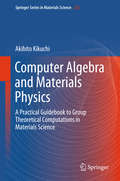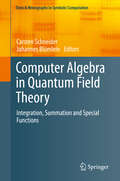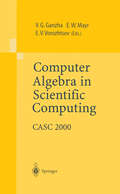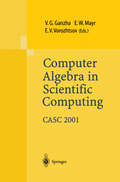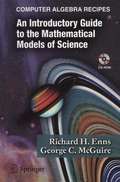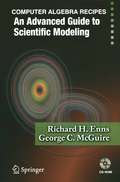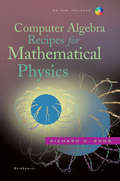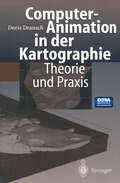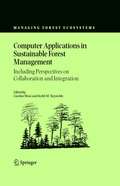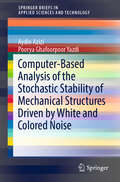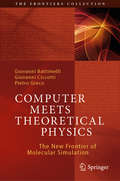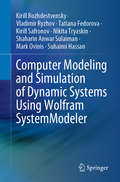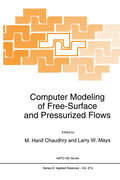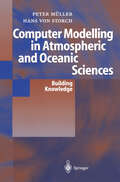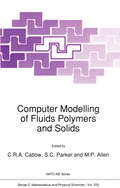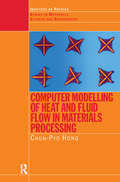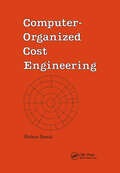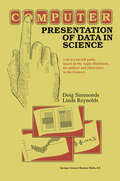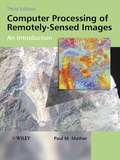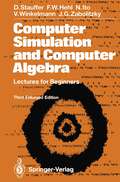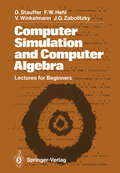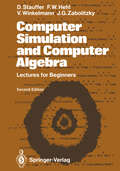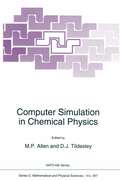- Table View
- List View
Computer Algebra and Materials Physics: A Practical Guidebook to Group Theoretical Computations in Materials Science (Springer Series in Materials Science #272)
by Akihito KikuchiThis book is intended as an introductory lecture in material physics, in which the modern computational group theory and the electronic structure calculation are in collaboration.The first part explains how to use computer algebra for applications in solid-state simulation, based on the GAP computer algebra package. Computer algebra enables us to easily obtain various group theoretical properties, such as the representations, character tables, and subgroups. Furthermore it offers a new perspective on material design, which could be executed in a mathematically rigorous and systematic way.The second part then analyzes the relation between the structural symmetry and the electronic structure in C60 (as an example of a system without periodicity). The principal object of the study was to illustrate the hierarchical change in the quantum-physical properties of the molecule, which correlates to the reduction in the symmetry (as it descends down in the ladder of subgroups).The book also presents the computation of the vibrational modes of the C60 by means of the computer algebra. In order to serve the common interests of researchers, the details of the computations (the required initial data and the small programs developed for the purpose) are explained in as much detail as possible.
Computer Algebra in Quantum Field Theory: Integration, Summation and Special Functions (Texts & Monographs in Symbolic Computation)
by Carsten Schneider and Johannes BlümleinThe book focuses on advanced computer algebra methods and special functions that have striking applications in the context of quantum field theory. It presents the state of the art and new methods for (infinite) multiple sums, multiple integrals, in particular Feynman integrals, difference and differential equations in the format of survey articles. The presented techniques emerge from interdisciplinary fields: mathematics, computer science and theoretical physics; the articles are written by mathematicians and physicists with the goal that both groups can learn from the other field, including most recent developments. Besides that, the collection of articles also serves as an up-to-date handbook of available algorithms/software that are commonly used or might be useful in the fields of mathematics, physics or other sciences.
Computer Algebra in Scientific Computing: CASC 2000
by Viktor G. Ganzha Ernst W. Mayr Evgenii V. VorozhtsovProceedings of the Third Workshop on Computer Algebra in Scientific Computing, Samarkand, Octobe5r 5-9, 2000
Computer Algebra in Scientific Computing CASC 2001: Proceedings of the Fourth International Workshop on Computer Algebra in Scientific Computing, Konstanz, Sept. 22-26, 2001
by Viktor G. Ganzha Ernst W. Mayr Evgenii V. VorozhtsovCASC 2001 continues a tradition ~ started in 1998 ~ of international con ferences on the latest advances in the application of computer algebra systems to the solution of various problems in scientific computing. The three ear (CASs) lier conferences in this sequence, CASC'98, CASC'99, and CASC 2000, were held, Petersburg, Russia, in Munich, Germany, and in Samarkand, respectively, in St. Uzbekistan, and proved to be very successful. We have to thank the program committee, listed overleaf, for a tremendous job in soliciting and providing reviews for the submitted papers. There were more than three reviews per submission on average. The result of this job is reflected in the present volume, which contains revised versions of the accepted papers. The collection of papers included in the proceedings covers various topics of computer algebra methods, algorithms and software applied to scientific computing. In particular, five papers are devoted to the implementation of the analysis of involutive systems with the aid of CASso The specific examples include new efficient algorithms for the computation of Janet bases for monomial ideals, involutive division, involutive reduction method, etc. A number of papers deal with application of CASs for obtaining and vali dating new exact solutions to initial and boundary value problems for partial differential equations in mathematical physics. Several papers show how CASs can be used to obtain analytic solutions of initial and boundary value problems for ordinary differential equations and for studying their properties.
Computer Algebra Recipes: An Introductory Guide to the Mathematical Models of Science
by Richard H. Enns George C. McGuire* Contains computer algebra worksheets or "recipes" designed using MAPLE (System 10); no prior knowledge of MAPLE is assumed* Effective computational science text for first- and second-year undergraduates in mathematics, physics, engineering, chemistry, economics, biology, and pre-medicine* Examples and problems provide basis for both self-study and on-line course
Computer Algebra Recipes: An Advanced Guide to Scientific Modeling
by Richard H. Enns George C. McGuireThis book presents a large number of computer algebra worksheets or "recipes" that have been designed using MAPLE to provide tools for problem solving and to stimulate critical thinking. No prior knowledge of MAPLE is necessary. All relevant commands are introduced on a need-to-know basis and are indexed for easy reference. Each recipe features a scientific model or method and an interesting or amusing story designed to both entertain and enhance concept comprehension and retention.
Computer Algebra Recipes for Mathematical Physics
by Richard H. Enns* Uses a pedagogical approach that makes a mathematically challenging subject easier and more fun to learn* Self-contained and standalone text that may be used in the classroom, for an online course, for self-study, as a reference* Using MAPLE allows the reader to easily and quickly change the models and parameters
Computer-Animation in der Kartographie: Theorie und Praxis
by Doris DranschDie Entwicklungen der Computer-Kartographie zielten bisher vor allem darauf ab, die Computertechnik so zu verbessern, daß die Computer-Karte immer mehr der Qualität der Papier-Karte angepasst werden konnte. Computer bieten jedoch weitaus größere Möglichkeiten für die kartographische Informationsdarstellung. Sie bieten ein neues Medium, das Information dynamisch und interaktiv wiedergeben kann, und sie bieten eine neue Technik, welche die schnelle und damit variable Darstellung räumlicher Information ermöglicht. Dieses Potential wird hier aufgezeigt und für die Kartographie nutzbar gemacht. Dazu wird ein Teilbereich der computergestützten Visualisierung, die Computer-Animation, daraufhin untersucht, wie sie für eine verbesserte kartographische Informationsdarstellung genutzt werden kann.
Computer Applications in Sustainable Forest Management: Including Perspectives on Collaboration and Integration (Managing Forest Ecosystems #11)
by Guofan Shao Keith M. ReynoldsThis book is the most comprehensive and up-to-date treatment of computer applications in forestry. It is the first text on software for forest management to emphasize integration of computer applications. It also offers important new insights on how to continue advancing computational technologies in forest management. The authors are internationally-recognized authorities in the subjects presented.
Computer-Based Analysis of the Stochastic Stability of Mechanical Structures Driven by White and Colored Noise (SpringerBriefs in Applied Sciences and Technology)
by Aydin Azizi Poorya Ghafoorpoor YazdiThis book provides a concise introduction to the behavior of mechanical structures and testing their stochastic stability under the influence of noise. It explains the physical effects of noise and in particular the concept of Gaussian white noise. In closing, the book explains how to model the effects of noise on mechanical structures, and how to nullify / compensate for it by designing effective controllers.
Computer Meets Theoretical Physics: The New Frontier of Molecular Simulation (The Frontiers Collection)
by Giovanni Battimelli Giovanni Ciccotti Pietro GrecoThis book provides a vivid account of the early history of molecular simulation, a new frontier for our understanding of matter that was opened when the demands of theoretical physicists were met by the availability of the modern computers. Since their inception, electronic computers have enormously increased their performance, thus making possible the unprecedented technological revolution that characterizes our present times. This obvious technological advancement has brought with it a silent scientific revolution in the practice of theoretical physics. In particular, in the physics of matter it has opened up a direct route from the microscopic physical laws to observable phenomena. One can now study the time evolution of systems composed of millions of molecules, and simulate the behaviour of macroscopic materials and actually predict their properties. Molecular simulation has provided a new theoretical and conceptual tool that physicists could only dream of when the foundations of statistical mechanics were laid. Molecular simulation has undergone impressive development, both in the size of the scientific community involved and in the range and scope of its applications. It has become the ubiquitous workhorse for investigating the nature of complex condensed matter systems in physics, chemistry, materials and the life sciences. Yet these developments remain largely unknown outside the inner circles of practitioners, and they have so far never been described for a wider public. The main objective of this book is therefore to offer a reasonably comprehensive reconstruction of the early history of molecular simulation addressed to an audience of both scientists and interested non-scientists, describing the scientific and personal trajectories of the main protagonists and discussing the deep conceptual innovations that their work produced.
Computer Modeling and Simulation of Dynamic Systems Using Wolfram SystemModeler
by Kirill Rozhdestvensky Vladimir Ryzhov Tatiana Fedorova Kirill Safronov Nikita Tryaskin Shaharin Anwar Sulaiman Mark Ovinis Suhaimi HassanThis book briefly discusses the main provisions of the theory of modeling. It also describes in detail the methodology for constructing computer models of dynamic systems using the Wolfram visual modeling environment, SystemModeler, and provides illustrative examples of solving problems of mechanics and hydraulics. Intended for students and professionals in the field, the book also serves as a supplement to university courses in modeling and simulation of dynamic systems.
Computer Modeling of Free-Surface and Pressurized Flows (NATO Science Series E: #274)
by M. Hanif Chaudhry L. MaysComputers are widely used for the analysis, design, and operation of water resource projects. This gives accurate results, allowing the analysis of complex systems which may not have been possible otherwise, and the investigation and comparison of several different alternatives in a short time, thereby reducing the project costs, optimizing design, and efficient utilization of resources. This volume compiles an edited version of the lecture notes specially prepared by 14 well-known European and North American researchers. Part I deals with free-surface flows. Governing equations are derived and their solution by the finite-difference, finite-element, and boundary-integral methods are discussed. Then, turbulence models, three-dimensional models, dam-break flow models, sediment transport models, and flood routing models are presented. Part II is related to the modeling of steady and transient pressurized flows. Governing equations for both single and two-component flows are derived and numerical methods for their solution are presented. The modeling of water quality in pipe networks, of cooling water systems, and slow and rapid transients is then discussed.
Computer Modelling in Atmospheric and Oceanic Sciences: Building Knowledge
by Peter K. MüllerThe book describes what these models are, what they are based on, how they function, and then, most innovatively, how they can be used to generate new useful knowledge about the environmental system. Discusses this generation of knowledge by computer models from an epistemological perspective and illustrates it by numerous examples from applied and fundamental research. Includes ample technical appendices and is a valuable source of information for graduate students and scientists alike working in the field of environmental sciences.
Computer Modelling of Fluids Polymers and Solids (Nato Science Series C: #293)
by Richard Catlow S. C. Parker M. P. AllenComputer Modelling techniques have developed very rapidly during the last decade, and interact with many contemporary scientific disciplines. One of the areas of greatest activity has concerned the modelling of condensed phases, including liquids solids and amorphous systems, where simulations have been used to provide insight into basic physical processes and in more recent years to make reliable predictions of the properties of the systems simulated. Indeed the predictive role of simulations is increasingly recognised both in academic and industrial contexts. Current active areas of application include topics as diverse as the viscosity of liquids, the conformation of proteins, the behaviour of hydrogen in metals, the diffusion of molecules in porous catalysts and the properties of micelles. This book, which is based on a NATO ASI held at the University of Bath, UK, from September 5th-17th, 1988, aims to give a general survey of this field, with detailed discussions both of methodologies and of applications. The earlier chapters of the book are devoted mainly to techniques and the later ones to recent simulation studies of fluids, polymers (including biological molecules) and solids. Special attention is paid to the role of interatomic potentials which are the fundamental physical input to simulations. In addition, developments in computer hardware are considered in depth, owing to the crucial role which such developments are playing in the expansion of the horizons of computer modelling studies.
Computer Modelling of Heat and Fluid Flow in Materials Processing
by C.P. HongThe understanding and control of transport phenomena in materials processing play an important role in the improvement of conventional processes and in the development of new techniques. Computer modeling of these phenomena can be used effectively for this purpose. Although there are several books in the literature covering the analysis of heat tra
Computer Modelling of Heat and Fluid Flow in Materials Processing
by C.P. HongThe understanding and control of transport phenomena in materials processing play an important role in the improvement of conventional processes and in the development of new techniques. Computer modeling of these phenomena can be used effectively for this purpose. Although there are several books in the literature covering the analysis of heat tra
Computer-Organized Cost Engineering
by Gideon SamidProviding a sequence of steps for matching cost engineering needs with helpful computer tools, this reference addresses the issues of project complexity and uncertainty; cost estimation, scheduling, and cost control; cost and result uncertainty; engineering and general purpose software; utilities th
Computer-Organized Cost Engineering
by Gideon SamidProviding a sequence of steps for matching cost engineering needs with helpful computer tools, this reference addresses the issues of project complexity and uncertainty; cost estimation, scheduling, and cost control; cost and result uncertainty; engineering and general purpose software; utilities th
Computer Presentation of Data in Science: a do-it-yourself guide, based on the Apple Macintosh, for authors and illustrators in the Sciences
by D. Simmonds L. ReynoldsBooks about printing written for printers or would-be printers go back over 300 years. The earliest of them were almost exclusively concerned with books; this century, however, there has been more emphasis on other kinds of documents, and particularly their design. But no shift in document production has been more sudden than the one that has happened most recently. ConSequently, the last five years have witnessed a substantial movement away from books written for professionals to ones whose aim is to help would-be authors produce their own documents. The opportunities for authors to do this have been opened up by the advent of desktop publishing (a term coined as recently as 1984). As most exponents of desktop publishing have come to realise, the term is something of a misnomer because the provision of facilities that allow authors to produce their own material for publishing is not quite the same thing as publish ing. Nevertheless, it has been useful in focussing attention on author-produced documents, and what might be described as the democratisation of document production. This book is different from others in the field. Its target audience is the busy scientist engaged in teaching or research who uses computers in the ordinary course of work. The world of scientific publishing is rapidly moving towards the day when journals will expect contributions from authors on disc, or even by direct transfer of data from the author's computer to the output device of an editor via telephone and satellite.
Computer Processing of Remotely-Sensed Images: An Introduction
by Paul M. MatherRemotely-sensed images of the Earth's surface provide a valuable source of information about the geographical distribution and properties of natural and cultural features. This fully revised and updated edition of a highly regarded textbook deals with the mechanics of processing remotely-senses images. Presented in an accessible manner, the book covers a wide range of image processing and pattern recognition techniques. Features include: New topics on LiDAR data processing, SAR interferometry, the analysis of imaging spectrometer image sets and the use of the wavelet transform. An accompanying CD-ROM with: updated MIPS software, including modules for standard procedures such as image display, filtering, image transforms, graph plotting, import of data from a range of sensors. A set of exercises, including data sets, illustrating the application of discussed methods using the MIPS software. An extensive list of WWW resources including colour illustrations for easy download. For further information, including exercises and latest software information visit the Author's Website at: http://homepage.ntlworld.com/paul.mather/ComputerProcessing3/
Computer Simulation and Computer Algebra: Lectures for Beginners
by Dietrich Stauffer Friedrich W Hehl Nobuyasu Ito Volker Winkelmann John G. ZabolitzkyComputer Simulation and Computer Algebra. Starting from simple examples in classical mechanics, these introductory lectures proceed to simulations in statistical physics (using FORTRAN) and then explain in detail the use of computer algebra (by means of Reduce). This third edition takes into account the most recent version of Reduce (3.4.1) and updates the description of large-scale simulations to subjects such as the 170000 X 170000 Ising model. Furthermore, an introduction to both vector and parallel computing is given.
Computer Simulation and Computer Algebra: Lectures for Beginners
by Dietrich Stauffer Friedrich W Hehl Volker Winkelmann John G. ZabolitzkyComputers play an increasingly important role in many of today's activities, and correspondingly physicists find employment after graduation in computer related jobs, often quite remote from their physics education. The present lectures, on the other hand, emphasize how we can use computers for the purposes of fundamental research in physics. Thus we do not deal with programs designed for newspapers, banks, or travel agencies, i.e., word processing and storage of large amounts of data. Instead, our lectures concentrate on physics problems, where the computer often has to work quite hard to get a result. Our programs are necessarily 5 quite short, excluding for example quantum chemistry programs with 10 program lines. The reader will learn how to handle computers for well-defined purposes. Therefore, in the end, this course will also enable him to orient himself in computer-related jobs. The first chapter deals mainly with solutions of the Newtonian equation of motion, that force equals mass times acceleration, which is a precursor to the molecular dynamics method in statistical physics. The second chap ter considers, by means of several examples, another method for statistical physics, Monte Carlo simulation. These two chapters deal with numbers, the traditional territory of computers. In contrast, analytic formula manipulation, 3 5 4 3 such as (a+27b -4c)5 = a + 135a b - ... , is taught in the last chapter and is important, for instance, in analytic integration or for evaluating expressions in Einstein's general theory of relativity.
Computer Simulation and Computer Algebra: Lectures for Beginners
by Dietrich Stauffer Friedrich W Hehl Volker Winkelmann John G. ZabolitzkyThe chapter on statistical-physics simulations has been enlarged, mainly by a dis cussion of multispin coding techniques for the Ising model (bit-by-bit parallel oper ations). In the chapter about Reduce, some details of the presentation have been cor rected or clarified. The new operator MATEIGEN for the computation of eigenvec tors of matrices is explained. The first chapter and the appendix remain unchanged. Needless to say, the field of computational science is advancing so quickly, for ex ample with the development of parallel, as opposed to vectorized, algorithms, that it will not be too long before a further edition is called for. Cologne, March 1989 The authors Preface to the First Edition Computers play an increasingly important role in many of today's activities, and correspondingly physicists find employment after graduation in computer related jobs, often quite remote from their physics education. The present lectures, on the other hand, emphasize how we can use computers for the purposes of fundamental research in physics. Thus we do not deal with programs designed for newspapers, banks, or travel agencies, i.e., word processing and storage of large amounts of data.
Computer Simulation in Chemical Physics (Nato Science Series C: #397)
by M. P. Allen D. J. TildesleyComputer Simulation in Chemical Physics contains the proceedings of a NATO Advanced Study Institute held at CORISA, Alghero, Sardinia, in September 1992. In the five years that have elapsed since the field was last summarized there have been a number of remarkable advances which have significantly expanded the scope of the methods. Good examples are the Car--Parrinello method, which allows the study of materials with itinerant electrons; the Gibbs technique for the direct simulation of liquid--vapor phase equilibria; the transfer of scaling concepts from simulations of spin models to more complex systems; and the development of the configurational--biased Monte-Carlo methods for studying dense polymers. The field has also been stimulated by an enormous increase in available computing power and the provision of new software. All these exciting developments, an more, are discussed in an accessible way here, making the book indispensable reading for graduate students and research scientists in both academic and industrial settings.
